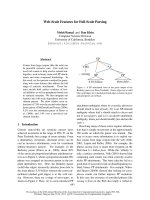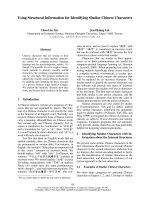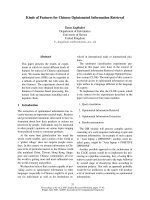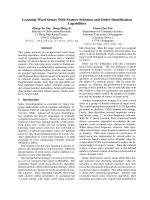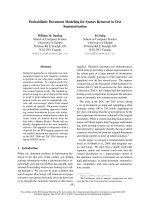Báo cáo khoa học: "Using Parse Features for Preposition Selection and Error Detection" ppt
Bạn đang xem bản rút gọn của tài liệu. Xem và tải ngay bản đầy đủ của tài liệu tại đây (107.39 KB, 6 trang )
Proceedings of the ACL 2010 Conference Short Papers, pages 353–358,
Uppsala, Sweden, 11-16 July 2010.
c
2010 Association for Computational Linguistics
Using Parse Features for Preposition Selection and Error Detection
Joel Tetreault
Educational Testing Service
Princeton
NJ, USA
Jennifer Foster
NCLT
Dublin City University
Ireland
Martin Chodorow
Hunter College of CUNY
New York, NY, USA
martin.chodorow
@hunter.cuny.edu
Abstract
We evaluate the effect of adding parse fea-
tures to a leading model of preposition us-
age. Results show a significant improve-
ment in the preposition selection task on
native speaker text and a modest increment
in precision and recall in an ESL error de-
tection task. Analysis of the parser output
indicates that it is robust enough in the face
of noisy non-native writing to extract use-
ful information.
1 Introduction
The task of preposition error detection has re-
ceived a considerable amount of attention in re-
cent years because selecting an appropriate prepo-
sition poses a particularly difficult challenge to
learners of English as a second language (ESL).
It is not only ESL learners that struggle with En-
glish preposition usage — automatically detecting
preposition errors made by ESL speakers is a chal-
lenging task for NLP systems. Recent state-of-the-
art systems have precision ranging from 50% to
80% and recall as low as 10% to 20%.
To date, the conventional wisdom in the error
detection community has been to avoid the use
of statistical parsers under the belief that a WSJ-
trained parser’s performance would degrade too
much on noisy learner texts and that the tradi-
tionally hard problem of prepositional phrase at-
tachment would be even harder when parsing ESL
writing. However, there has been little substantial
research to support or challenge this view. In this
paper, we investigate the following research ques-
tion: Are parser output features helpful in mod-
eling preposition usage in well-formed text and
learner text?
We recreate a state-of-the-art preposition usage
system (Tetreault and Chodorow (2008), hence-
forth T&C08) originally trained with lexical fea-
tures and augment it with parser output features.
We employ the Stanford parser in our experiments
because it consists of a competitive phrase struc-
ture parser and a constituent-to-dependency con-
version tool (Klein and Manning, 2003a; Klein
and Manning, 2003b; de Marneffe et al., 2006;
de Marneffe and Manning, 2008). We com-
pare the original model with the parser-augmented
model on the tasks of preposition selection in well-
formed text (fluent writers) and preposition error
detection in learner texts (ESL writers).
This paper makes the following contributions:
• We demonstrate that parse features have a
significant impact on preposition selection in
well-formed text. We also show which fea-
tures have the greatest effect on performance.
• We show that, despite the noisiness of learner
text, parse features can actually make small,
albeit non-significant, improvements to the
performance of a state-of-the-art preposition
error detection system.
• We evaluate the accuracy of parsing and
especially preposition attachment in learner
texts.
2 Related Work
T&C08, De Felice and Pulman (2008) and Ga-
mon et al. (2008) describe very similar preposi-
tion error detection systems in which a model of
correct prepositional usage is trained from well-
formed text and a writer’s preposition is com-
pared with the predictions of this model. It is
difficult to directly compare these systems since
they are trained and tested on different data sets
353
but they achieve accuracy in a similar range. Of
these systems, only the DAPPER system (De Fe-
lice and Pulman, 2008; De Felice and Pulman,
2009; De Felice, 2009) uses a parser, the C&C
parser (Clark and Curran, 2007)), to determine
the head and complement of the preposition. De
Felice and Pulman (2009) remark that the parser
tends to be misled more by spelling errors than
by grammatical errors. The parser is fundamental
to their system and they do not carry out a com-
parison of the use of a parser to determine the
preposition’s attachments versus the use of shal-
lower techniques. T&C08, on the other hand, re-
ject the use of a parser because of the difficulties
they foresee in applying one to learner data. Her-
met et al. (2008) make only limited use of the
Xerox Incremental Parser in their preposition er-
ror detection system. They split the input sentence
into the chunks before and after the preposition,
and parse both chunks separately. Only very shal-
low analyses are extracted from the parser output
because they do not trust the full analyses.
Lee and Knutsson (2008) show that knowl-
edge of the PP attachment site helps in the task
of preposition selection by comparing a classifier
trained on lexical features (the verb before the
preposition, the noun between the verb and the
preposition, if any, and the noun after the preposi-
tion) to a classifier trained on attachment features
which explicitly state whether the preposition is
attached to the preceding noun or verb. They also
argue that a parser which is capable of distinguish-
ing between arguments and adjuncts is useful for
generating the correct preposition.
3 Augmenting a Preposition Model with
Parse Features
To test the effects of adding parse features to
a model of preposition usage, we replicated the
lexical and combination feature model used in
T&C08, training on 2M events extracted from a
corpus of news and high school level reading ma-
terials. Next, we added the parse features to this
model to create a new model “+Parse”. In 3.1 we
describe the T&C08 system and features, and in
3.2 we describe the parser output features used to
augment the model. We illustrate our features us-
ing the example phrase many local groups around
the country. Fig. 1 shows the phrase structure tree
and dependency triples returned by the Stanford
parser for this phrase.
3.1 Baseline System
The work of Chodorow et al. (2007) and T&C08
treat the tasks of preposition selection and er-
ror detection as a classification problem. That
is, given the context around a preposition and a
model of correct usage, a classifier determines
which of the 34 prepositions covered by the model
is most appropriate for the context. A model of
correct preposition usage is constructed by train-
ing a Maximum Entropy classifier (Ratnaparkhi,
1998) on millions of preposition contexts from
well-formed text.
A context is represented by 25 lexical features
and 4 combination features:
Lexical Token and POS n-grams in a 2 word
window around the preposition, plus the head verb
in the preceding verb phrase (PV), the head noun
in the preceding noun phrase (PN) and the head
noun in the following noun phrase (FN) when
available (Chodorow et al., 2007). Note that these
are determined not through full syntactic parsing
but rather through the use of a heuristic chun-
ker. So, for the phrase many local groups around
the country, examples of lexical features for the
preposition around include: FN = country, PN =
groups, left-2-word-sequence = local-groups, and
left-2-POS-sequence = JJ-NNS.
Combination T&C08 expand on the lexical fea-
ture set by combining the PV, PN and FN fea-
tures, resulting in features such as PN-FN and
PV-PN-FN. POS and token versions of these fea-
tures are employed. The intuition behind creat-
ing combination features is that the Maximum En-
tropy classifier does not automatically model the
interactions between individual features. An ex-
ample of the PN-FN feature is groups-country.
3.2 Parse Features
To augment the above model we experimented
with 14 features divided among five main classes.
Table 1 shows the features and their values for
our around example. The Preposition Head and
Complement feature represents the two basic at-
tachment relations of the preposition, i.e. its head
(what it is attached to) and its complement (what
is attached to it). Relation specifies the relation
between the head and complement. The Preposi-
tion Head and Complement Combined features
are similar to the T&C08 Combination features
except that they are extracted from parser output.
354
NP
NP
DT
many
JJ
local
NNS
groups
PP
IN
around
NP
DT
the
NN
country
amod(groups-3, many-1)
amod(groups-3, local-2)
prep(groups-3, around-4)
det(country-6, the-5)
pobj(around-4, country-6)
Figure 1: Phrase structure tree and dependency
triples produced by the Stanford parser for the
phrase many local groups around the country
Prep. Head & Complement
1. head of the preposition: groups
2. POS of the head: NNS
3. complement of the preposition: country
4. POS of the complement: NN
Prep. Head & Complement Relation
5. Prep-Head relation name: prep
6. Prep-Comp relation name: pobj
Prep. Head & Complement Combined
7. Head-Complement tokens: groups-country
8. Head-Complement tags: NNS-NN
Prep. Head & Complement Mixed
9. Head Tag and Comp Token: NNS-country
10. Head Token and Comp Tag: groups-NN
Phrase Structure
11. Preposition Parent: PP
12. Preposition Grandparent: NP
13. Left context of preposition parent: NP
14. Right context of preposition parent: -
Table 1: Parse Features
Model Accuracy
combination only 35.2
parse only 60.6
combination+parse 61.9
lexical only 64.4
combination+lexical (T&C08) 65.2
lexical+parse 68.1
all features (+Parse) 68.5
Table 2: Accuracy on preposition selection task
for various feature combinations
The Preposition Head and Complement Mixed
features are created by taking the first feature in
the previous set and backing-off either the head
or the complement to its POS tag. This mix of
tags and tokens in a word-word dependency has
proven to be an effective feature in sentiment anal-
ysis (Joshi and Penstein-Ros
´
e, 2009). All the fea-
tures described so far are extracted from the set of
dependency triples output by the Stanford parser.
The final set of features (Phrase Structure), how-
ever, is extracted directly from the phrase structure
trees themselves.
4 Evaluation
In Section 4.1, we compare the T&C08 and +Parse
models on the task of preposition selection on
well-formed texts written by native speakers. For
every preposition in the test set, we compare the
system’s top preposition for that context to the
writer’s preposition, and report accuracy rates. In
Section 4.2, we evaluate the two models on ESL
data. The task here is slightly different - if the
most likely preposition according to the model dif-
fers from the likelihood of the writer’s preposition
by a certain threshold amount, a preposition error
is flagged.
4.1 Native Speaker Test Data
Our test set consists of 259K preposition events
from the same source as the original training data.
The T&C08 model performs at 65.2% and when
the parse features are added, the +Parse model im-
proves performance by more than 3% to 68.5%.
1
The improvement is statistically significant.
1
Prior research has shown preposition selection perfor-
mance accuracy ranging from 65% to nearly 80%. The dif-
ferences are largely due to different test sets and also training
sizes. Given the time required to train large models, we report
here experiments with a relatively small model.
355
Model Accuracy
T&C08 65.2
+Phrase Structure Only 67.1
+Dependency Only 68.2
+Parse 68.5
+head-tag+comp-tag 66.9
+left 66.8
+grandparent 66.6
+head-token+comp-tag 66.6
+head-tag 66.5
+head-token 66.4
+head-tag+comp-token 66.1
Table 3: Which parse features are important? Fea-
ture Addition Experiment
Table 2 shows the effect of various feature class
combinations on prediction accuracy. The results
are clear: a significant performance improvement
is obtained on the preposition selection task when
features from parser output are added. The two
best models in Table 2 contain parse features. The
table also shows that the non-parser-based feature
classes are not entirely subsumed by the parse fea-
tures but rather provide, to varying degrees, com-
plementary information.
Having established the effectiveness of parse
features, we investigate which parse feature
classes contribute the most. To test each contri-
bution, we perform a feature addition experiment,
separately adding features to the T&C08 model
(see Table 3). We make three observations. First,
while there is overlapping information between
the dependency features and the phrase structure
features, the phrase structure features are mak-
ing a contribution. This is interesting because
it suggests that a pure dependency parser might
be less useful than a parser which explicitly pro-
duces both constituent and dependency informa-
tion. Second, using a parser to identify the prepo-
sition head seems to be more useful than using it to
identify the preposition complement.
2
Finally, as
was the case for the T&C08 features, the combina-
tion parse features are also important (particularly
the tag-tag or tag/token pairs).
4.2 ESL Test Data
Our test data consists of 5,183 preposition events
extracted from a set of essays written by non-
2
De Felice (2009) observes the same for the DAPPER sys-
tem.
Method Precision Recall
T&C08 0.461 0.215
+Parse 0.486 0.225
Table 4: ESL Error Detection Results
native speakers for the Test of English as a Foreign
Language (TOEFL
R
). The prepositions were
judged by two trained annotators and checked
by the authors using the preposition annotation
scheme described in Tetreault and Chodorow
(2008b). 4,881 of the prepositions were judged to
be correct and the remaining 302 were judged to
be incorrect.
The writer’s preposition is flagged as an error by
the system if its likelihood according to the model
satisfied a set of criteria (e.g., the difference be-
tween the probability of the system’s choice and
the writer’s preposition is 0.8 or higher). Un-
like the selection task where we use accuracy as
the metric, we use precision and recall with re-
spect to error detection. To date, performance
figures that have been reported in the literature
have been quite low, reflecting the difficulty of the
task. Table 4 shows the performance figures for
the T&C08 and +Parse models. Both precision
and recall are higher for the +Parse model, how-
ever, given the low number of errors in our an-
notated test set, the difference is not statistically
significant.
5 Parser Accuracy on ESL Data
To evaluate parser performance on ESL data,
we manually inspected the phrase structure trees
and dependency graphs produced by the Stanford
parser for 210 ESL sentences, split into 3 groups:
the sentences in the first group are fluent and con-
tain no obvious grammatical errors, those in the
second contain at least one preposition error and
the sentences in the third are clearly ungrammati-
cal with a variety of error types. For each preposi-
tion we note whether the parser was successful in
determining its head and complement. The results
for the three groups are shown in Table 5. The
figures in the first row are for correct prepositions
and those in the second are for incorrect ones.
The parser tends to do a better job of de-
termining the preposition’s complement than its
head which is not surprising given the well-known
problem of PP attachment ambiguity. Given the
preposition, the preceding noun, the preceding
356
OK
Head Comp
Prep Correct 86.7% (104/120) 95.0% (114/120)
Prep Incorrect - -
Preposition Error
Head Comp
Prep Correct 89.0% (65/73) 97.3% (71/73)
Prep Incorrect 87.1% (54/62) 96.8% (60/62)
Ungrammatical
Head Comp
Prep Correct 87.8% (115/131) 89.3% (117/131)
Prep Incorrect 70.8% (17/24) 87.5% (21/24)
Table 5: Parser Accuracy on Prepositions in a
Sample of ESL Sentences
verb and the following noun, Collins (1999) re-
ports an accuracy rate of 84.5% for a PP attach-
ment classifier. When confronted with the same
information, the accuracy of three trained annota-
tors is 88.2%. Assuming 88.2% as an approximate
PP-attachment upper bound, the Stanford parser
appears to be doing a good job. Comparing the
results over the three sentence groups, its ability
to identify the preposition’s head is quite robust to
grammatical noise.
Preposition errors in isolation do not tend to
mislead the parser: in the second group which con-
tains sentences which are largely fluent apart from
preposition errors, there is little difference be-
tween the parser’s accuracy on the correctly used
prepositions and the incorrectly used ones. Exam-
ples are
(S (NP I)
(VP had
(NP (NP a trip)
(PP for (NP Italy))
)
)
)
in which the erroneous preposition for is correctly
attached to the noun trip, and
(S (NP A scientist)
(VP devotes
(NP (NP his prime part)
(PP of (NP his life))
)
(PP in (NP research))
)
)
in which the erroneous preposition in is correctly
attached to the verb devotes.
6 Conclusion
We have shown that the use of a parser can boost
the accuracy of a preposition selection model
tested on well-formed text. In the error detection
task, the improvement is less marked. Neverthe-
less, examination of parser output shows the parse
features can be extracted reliably from ESL data.
For our immediate future work, we plan to carry
out the ESL evaluation on a larger test set to bet-
ter gauge the usefulness of a parser in this context,
to carry out a detailed error analysis to understand
why certain parse features are effective and to ex-
plore a larger set of features.
In the longer term, we hope to compare different
types of parsers in both the preposition selection
and error detection tasks, i.e. a task-based parser
evaluation in the spirit of that carried out by Miyao
et al. (2008) on the task of protein pair interaction
extraction. We would like to further investigate
the role of parsing in error detection by looking at
other error types and other text types, e.g. machine
translation output.
Acknowledgments
We would like to thank Rachele De Felice and the
reviewers for their very helpful comments.
References
Martin Chodorow, Joel Tetreault, and Na-Rae Han.
2007. Detection of grammatical errors involv-
ing prepositions. In Proceedings of the 4th ACL-
SIGSEM Workshop on Prepositions, Prague, Czech
Republic, June.
Stephen Clark and James R. Curran. 2007. Wide-
coverage efficient statistical parsing with CCG
and log-linear models. Computational Linguistics,
33(4):493–552.
Michael Collins. 1999. Head-driven Statistical Mod-
els for Natural Language Parsing. Ph.D. thesis,
University of Pennsylvania.
Rachele De Felice and Stephen G. Pulman. 2008. A
classifier-based approach to preposition and deter-
miner error correction in L2 english. In Proceedings
of the 22nd COLING, Manchester, United Kingdom.
Rachele De Felice and Stephen Pulman. 2009. Au-
tomatic detection of preposition errors in learning
writing. CALICO Journal, 26(3):512–528.
Rachele De Felice. 2009. Automatic Error Detection
in Non-native English. Ph.D. thesis, Oxford Univer-
sity.
357
Marie-Catherine de Marneffe and Christopher D. Man-
ning. 2008. The stanford typed dependencies repre-
sentation. In Proceedings of the COLING08 Work-
shop on Cross-framework and Cross-domain Parser
Evaluation, Manchester, United Kingdom.
Marie-Catherine de Marneffe, Bill MacCartney, and
Christopher D. Manning. 2006. Generating typed
dependency parses from phrase structure parses. In
Proceedings of LREC, Genoa, Italy.
Michael Gamon, Jianfeng Gao, Chris Brockett,
Alexandre Klementiev, William B. Dolan, Dmitriy
Belenko, and Lucy Vanderwende. 2008. Using con-
textual speller techniques and language modelling
for ESL error correction. In Proceedings of the In-
ternational Joint Conference on Natural Language
Processing, Hyderabad, India.
Matthieu Hermet, Alain D
´
esilets, and Stan Szpakow-
icz. 2008. Using the web as a linguistic resource
to automatically correct lexico-syntactic errors. In
Proceedings of LREC, Marrekech, Morocco.
Mahesh Joshi and Carolyn Penstein-Ros
´
e. 2009. Gen-
eralizing dependency features for opinion mining.
In Proceedings of the ACL-IJCNLP 2009 Confer-
ence Short Papers, pages 313–316, Singapore.
Dan Klein and Christopher D. Manning. 2003a. Ac-
curate unlexicalized parsing. In Proceedings of the
41st Annual Meeting of the ACL, pages 423–430,
Sapporo, Japan.
Dan Klein and Christopher D. Manning. 2003b. Fast
exact inference with a factored model for exact pars-
ing. In Advances in Neural Information Processing
Systems, pages 3–10. MIT Press, Cambridge, MA.
John Lee and Ola Knutsson. 2008. The role of PP at-
tachment in preposition generation. In Proceedings
of CICling. Springer-Verlag Berlin Heidelberg.
Yusuke Miyao, Rune Saetre, Kenji Sagae, Takuya Mat-
suzaki, and Jun’ichi Tsujii. 2008. Task-oriented
evaluation of syntactic parsers and their representa-
tions. In Proceedings of the 46th Annual Meeting of
the ACL, pages 46–54, Columbus, Ohio.
Adwait Ratnaparkhi. 1998. Maximum Entropy Mod-
els for natural language ambiguity resolution. Ph.D.
thesis, University of Pennsylvania.
Joel Tetreault and Martin Chodorow. 2008. The ups
and downs of preposition error detection in ESL
writing. In Proceedings of the 22nd COLING,
Manchester, United Kingdom.
Joel Tetreault and Martin Chodorow. 2008b. Na-
tive Judgments of non-native usage: Experiments in
preposition error detection. In COLING Workshop
on Human Judgments in Computational Linguistics,
Manchester, United Kingdom.
358
